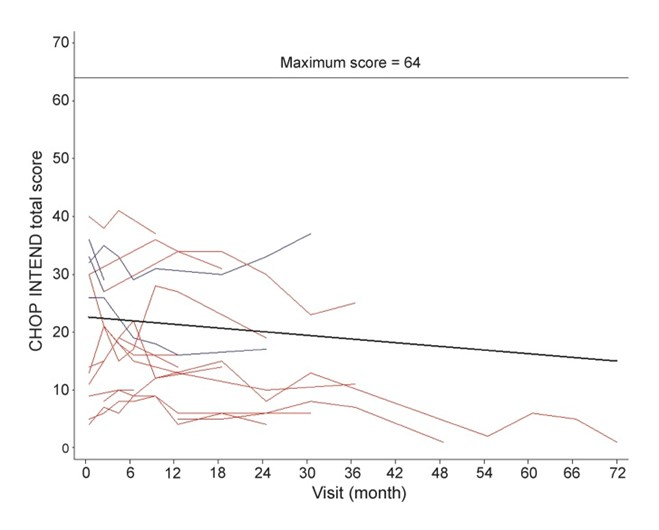CHOP INTEND (Children’s Hospital Of Philadelphia Infant Test Of Neuromuscular Disorders)
CHOP INTEND (Children’s Hospital Of Philadelphia Infant Test Of Neuromuscular Disorders)
Page last checked: 29th November 2022
Last updated: 15th February 2022
What is it and how is it scored?
CHOP INTEND was developed to be used on children from 3 months to over four years, although it is not limited to this age range. It was developed by looking at babies with SMA Type 1 and infants with other conditions¹. There are 16 parts and the scale scores infants on how well they can perform certain movements or what the physiotherapist sees whilst watching the child. Each one is scored from 0 to 4, with 0 being no response/ability to perform the movement and 4 being ‘complete response’ (being able to perform the task). The total possible score is 64.
Further information about what is measured and scored:
What has been reported as the usual score for an infant with SMA Type 1 without drug treatment over time?
Unlike other assessment tools, CHOP INTEND was developed with SMA evaluation in mind. A study conducted by Kolb and colleagues found that infants with SMA Type 1 scored much lower on average (20) than unaffected infants of the same age (50)². In a natural history study looking at infants with Type 1 SMA, the following graph was shown to highlight the course of how infants score over time. Each line represents an infant and their score on this test over time. As infants get older their score slowly declines, though as the graph shows, there is a lot of variation between individuals as to how quickly this happens.

From Kolb SJ, Coffey CS, Yankey JW, et al. Baseline results of the NeuroNEXT spinal muscular atrophy infant biomarker study. Each line shows the change in an individual child’s CHOP INTEND score over time.
References
1. Glanzman AM, Mazzone E, Main M, et al. The Children’s Hospital of Philadelphia Infant Test of Neuromuscular Disorders (CHOP INTEND): test development and reliability. Neuromuscul Disord. 2010;20(3):155–161. doi:10.1016/j.nmd.2009.11.014
2. Kolb SJ, Coffey CS, Yankey JW, et al. Baseline results of the NeuroNEXT spinal muscular atrophy infant biomarker study. Ann Clin Transl Neurol. 2016;3(2):132–145. Published 2016 Jan 21. doi:10.1002/acn3.283
